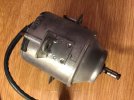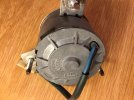Dr.Jeff
True Classic
In another (related) thread we've been talking about radiators. It reminded me of a great family company in SoCal (Mattson Custom Radiator in the City of Stanton) that has been building custom radiators, as well as all related aspects, for decades. It was started by the grandfather (Jack Mattson) way back in the 50's or 60's and is now run by the grandson. All three generations are named Jack so it gets confusing, but the dad (Jack 2) of the current owner (Jack 3) was one of the nicest guys I've met in the automotive industry. He earned the nickname "fan man" because electric fans was his thing. He had what I believe to be the first rights to sell Spal products in this region. They have been a staple at the Pomona and Long Beach car swap meets for as long as I can remember.
I had a long conversation with Jack 2 at one of the swap meets once and he told me the following basic rules to mounting fans on radiators. I took notes as he talked and I've rewritten it a few times over the years so I won't lose it:
1) For a "puller" fan mounted behind the radiator, put the front edge of the fan blade 5/8" to 3/4" from the radiator core surface.
2) For a "pusher" fan mounted in front of the radiator, put the trailing edge of a straight blade fan 1/4" from the surface of the core (due to the lack of a shroud, see #3).
3) Always use a fan shroud on a rear mounted "puller" fan. Never use a shroud on a front mounted "pusher" fan. Add air bypass doors to the fan shroud in areas where the fan does not cover the core. This allows air to flow past the shroud when the fan isn't running.
4) If AC is installed mount the condenser 1/2" in front of the radiator core (surface to surface gap).
5) Never use those "through the core" zip-tie mounts to install a fan on a radiator.
6) Use a fan control temp switch slightly higher than the thermostat rating.
7) He preferred circuit breakers over fuses. And for a two fan setup he used two relays, but both can be controlled by one temp switch.
8) Use the thickest (vs "slim") fan that will fit.
9) The size and number of fans is different with puller and pusher setups:
9a) For a puller installation use a fan or fans that cover as much of the core as possible. Even if part of the fan's blades extend beyond the edges of the core in one dimension. The extra overlap of fan can be covered by a small shroud to prevent sucking air from around the rad.
9b) For a pusher installation do not allow the fan's blades to extend beyond the edges of the core. Even if that means some core area is not covered.
9c) Therefore the number and size of fan(s) will depend on achieving these criteria (9a and 9b) more than anything else. In the event that either one or two fans will result in the same coverage, then one fan is better than two. (I don't recall why).
Bear in mind the majority of applications they see are things like muscle cars, hotrods, custom builds, etc. A Fiat X1/9 cooling system certainly isn't one of those, but I imagine all of the same principle rules should apply.
We'll add more posts about fan CFM ratings, controller principles, brands, sizes, etc.
I had a long conversation with Jack 2 at one of the swap meets once and he told me the following basic rules to mounting fans on radiators. I took notes as he talked and I've rewritten it a few times over the years so I won't lose it:
1) For a "puller" fan mounted behind the radiator, put the front edge of the fan blade 5/8" to 3/4" from the radiator core surface.
2) For a "pusher" fan mounted in front of the radiator, put the trailing edge of a straight blade fan 1/4" from the surface of the core (due to the lack of a shroud, see #3).
3) Always use a fan shroud on a rear mounted "puller" fan. Never use a shroud on a front mounted "pusher" fan. Add air bypass doors to the fan shroud in areas where the fan does not cover the core. This allows air to flow past the shroud when the fan isn't running.
4) If AC is installed mount the condenser 1/2" in front of the radiator core (surface to surface gap).
5) Never use those "through the core" zip-tie mounts to install a fan on a radiator.
6) Use a fan control temp switch slightly higher than the thermostat rating.
7) He preferred circuit breakers over fuses. And for a two fan setup he used two relays, but both can be controlled by one temp switch.
8) Use the thickest (vs "slim") fan that will fit.
9) The size and number of fans is different with puller and pusher setups:
9a) For a puller installation use a fan or fans that cover as much of the core as possible. Even if part of the fan's blades extend beyond the edges of the core in one dimension. The extra overlap of fan can be covered by a small shroud to prevent sucking air from around the rad.
9b) For a pusher installation do not allow the fan's blades to extend beyond the edges of the core. Even if that means some core area is not covered.
9c) Therefore the number and size of fan(s) will depend on achieving these criteria (9a and 9b) more than anything else. In the event that either one or two fans will result in the same coverage, then one fan is better than two. (I don't recall why).
Bear in mind the majority of applications they see are things like muscle cars, hotrods, custom builds, etc. A Fiat X1/9 cooling system certainly isn't one of those, but I imagine all of the same principle rules should apply.
We'll add more posts about fan CFM ratings, controller principles, brands, sizes, etc.
Last edited:


